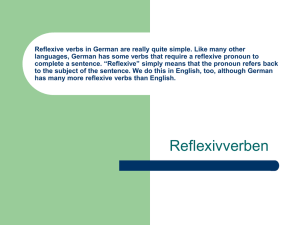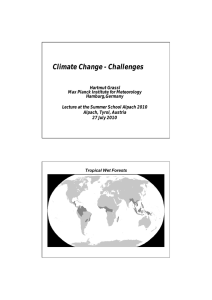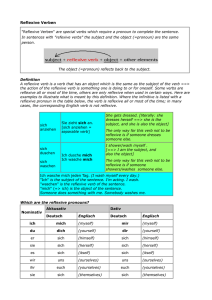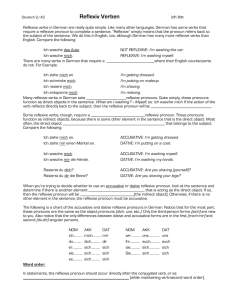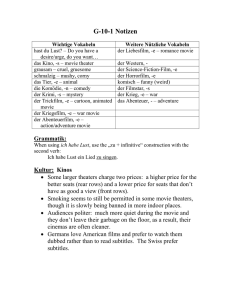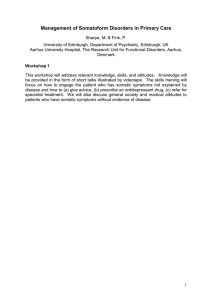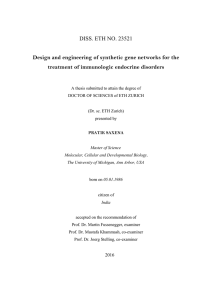Auxiliary selection and perfective verb particles in Cimbrian reflexive
Werbung
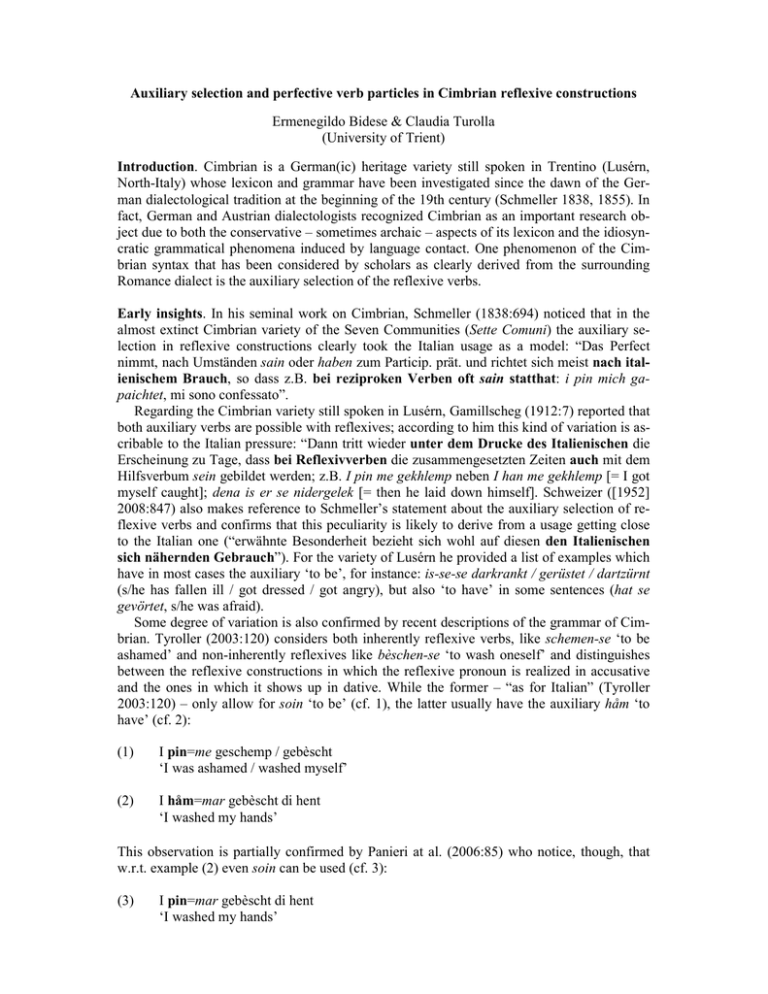
Auxiliary selection and perfective verb particles in Cimbrian reflexive constructions Ermenegildo Bidese & Claudia Turolla (University of Trient) Introduction. Cimbrian is a German(ic) heritage variety still spoken in Trentino (Lusérn, North-Italy) whose lexicon and grammar have been investigated since the dawn of the German dialectological tradition at the beginning of the 19th century (Schmeller 1838, 1855). In fact, German and Austrian dialectologists recognized Cimbrian as an important research object due to both the conservative – sometimes archaic – aspects of its lexicon and the idiosyncratic grammatical phenomena induced by language contact. One phenomenon of the Cimbrian syntax that has been considered by scholars as clearly derived from the surrounding Romance dialect is the auxiliary selection of the reflexive verbs. Early insights. In his seminal work on Cimbrian, Schmeller (1838:694) noticed that in the almost extinct Cimbrian variety of the Seven Communities (Sette Comuni) the auxiliary selection in reflexive constructions clearly took the Italian usage as a model: “Das Perfect nimmt, nach Umständen sain oder haben zum Particip. prät. und richtet sich meist nach italienischem Brauch, so dass z.B. bei reziproken Verben oft sain statthat: i pin mich gapaichtet, mi sono confessato”. Regarding the Cimbrian variety still spoken in Lusérn, Gamillscheg (1912:7) reported that both auxiliary verbs are possible with reflexives; according to him this kind of variation is ascribable to the Italian pressure: “Dann tritt wieder unter dem Drucke des Italienischen die Erscheinung zu Tage, dass bei Reflexivverben die zusammengesetzten Zeiten auch mit dem Hilfsverbum sein gebildet werden; z.B. I pin me gekhlemp neben I han me gekhlemp [= I got myself caught]; dena is er se nidergelek [= then he laid down himself]. Schweizer ([1952] 2008:847) also makes reference to Schmeller’s statement about the auxiliary selection of reflexive verbs and confirms that this peculiarity is likely to derive from a usage getting close to the Italian one (“erwähnte Besonderheit bezieht sich wohl auf diesen den Italienischen sich nähernden Gebrauch”). For the variety of Lusérn he provided a list of examples which have in most cases the auxiliary ‘to be’, for instance: is-se-se darkrankt / gerüstet / dartzürnt (s/he has fallen ill / got dressed / got angry), but also ‘to have’ in some sentences (hat se gevörtet, s/he was afraid). Some degree of variation is also confirmed by recent descriptions of the grammar of Cimbrian. Tyroller (2003:120) considers both inherently reflexive verbs, like schemen-se ‘to be ashamed’ and non-inherently reflexives like bèschen-se ‘to wash oneself’ and distinguishes between the reflexive constructions in which the reflexive pronoun is realized in accusative and the ones in which it shows up in dative. While the former – “as for Italian” (Tyroller 2003:120) – only allow for soin ‘to be’ (cf. 1), the latter usually have the auxiliary håm ‘to have’ (cf. 2): (1) I pin=me geschemp / gebèscht ‘I was ashamed / washed myself’ (2) I håm=mar gebèscht di hent ‘I washed my hands’ This observation is partially confirmed by Panieri at al. (2006:85) who notice, though, that w.r.t. example (2) even soin can be used (cf. 3): (3) I pin=mar gebèscht di hent ‘I washed my hands’ State of the art. The auxiliary selection in reflexive constructions was the subject of a pilot study carried out in 2007 with 7 speakers of Cimbrian and reported by Kolmer (2010). The provisional results of her investigation can be summarized as follows: (i) Tyroller’s generalization seems to be confirmed: the selection of håm is only possible when the reflexive marker is a dative pronoun which refers to the subject without being requested by the verb valency (cf. above, 2), otherwise soin must be selected (cf. above, 3). Kolmer (2010:150) refers to this generalization as to a kind of ‘split auxiliary’system. (ii) Tyroller’s generalization holds only for the oldest generation of speakers and represents the conservative norm. The middle and younger generation seem to move towards a generalized use of soin (cf. 4) possibly under the influence of the Italian construction. (4) si iz=ar gestrelt ‘z har she is=her.DAT combed the hair ‘she combed her hair’ (26 years-old speaker) (Kolmer 2010:153) Aims. Our talk aims to present the results of a new study carried out with 30 speakers of Cimbrian on the basis of a larger set of reflexive verbs and reflexive constructions. The novel data collected confirms Tyroller’s generalization and Kolmer’s interpretation of it (cf. above, (i)). On the contrary, as for (ii), it does not seem to support the idea of a general change towards the auxiliary soin as the only auxiliary in reflexive constructions; moreover, the data suggest a differentiation in the auxiliary selection possibly due to the persons of the paradigm (1th and 2th singular vs. 3th singular, that behaves differently with this respect), as already shown in Loporcaro & Vigolo (1995) and Cordin (2009) for some Romance varieties spoken in Valsugana and Vallagarina (TN). Our second purpose is to investigate which role perfective verb particles like vor-, bo- or the typically Bavarian superperfective particle dar- may play. As a matter of fact, verbs that include this particles allow only for ‘to be’ among all generations of speakers without any kind of variation: (5) *Dar Håns hatt-ze darzürnt the H. has-itself anger ‘H. got angry’ References ● Kolmer, A. (2010): Kontaktbedingte Veränderung der Hilfsverbselektion im Cimbro Ergebnisse einer Pilotstudie. In: Scherer, C. & A. Holler, Strategien der Integration und Isolation nicht-nativer Einheiten und Strukturen. Berlin: de Gruyter, 143-164. ● Loporcaro, M. & M. T. Vigolo (1995): Ricerche sintattiche sul confine dialettale veneto trentino in Valsugana: l'accordo passato. In: E. Banfi et al. (eds.): Italia settentrionale: crocevia di idiomi romanzi. Atti del convegno internazionale di studi. Trento, 21–23 ottobre 1993. Tübingen: Niemeyer, 87-101. ● Gamillscheg, E. (1912): Die romanischen Elemente in der deutschen Mundart von Lusern. Halle/S.: Niemeyer. ● Panieri, L. & M. Pedrazza, A. Nicolussi Baiz, S. Hipp, C. Pruner (ed.) (2006): Bar lirnen z’schraiba un zo reda az be biar / Grammatica del cimbro di Luserna / Grammatik der zimbrischen Sprache von Lusérn. Trento: Regione Autonoma Trentino-Alto Adige. ● Schmeller, J. A. (1838): Ueber die sogenannten Cim-bern der VII und XIII Communen auf den Venedischen Alpen und ihre Sprache. In: Denkschriften der bayer. Akademie der Wissenschaften 15 – Abhandlungen der philos.-philol. Klasse 2, 555-708. ● Schmeller, J. A. (1855): Cimbrisches Wörterbuch, das ist deutsches Idiotikon der VII. und XIII. Comuni in den venetianischen Alpen. Edited by J. Bergmann. Wien: Hof- und Staatsdruckerei. ● Schweizer, B. ([1952] 2008): Zimbrische Gesamtgrammatik. Edited by J. R. Dow. Stuttgart: Steiner. ● Tyroller, H. (2003): Grammatische Beschreibung des Zimbrischen von Lusern. Stuttgart: Steiner.
